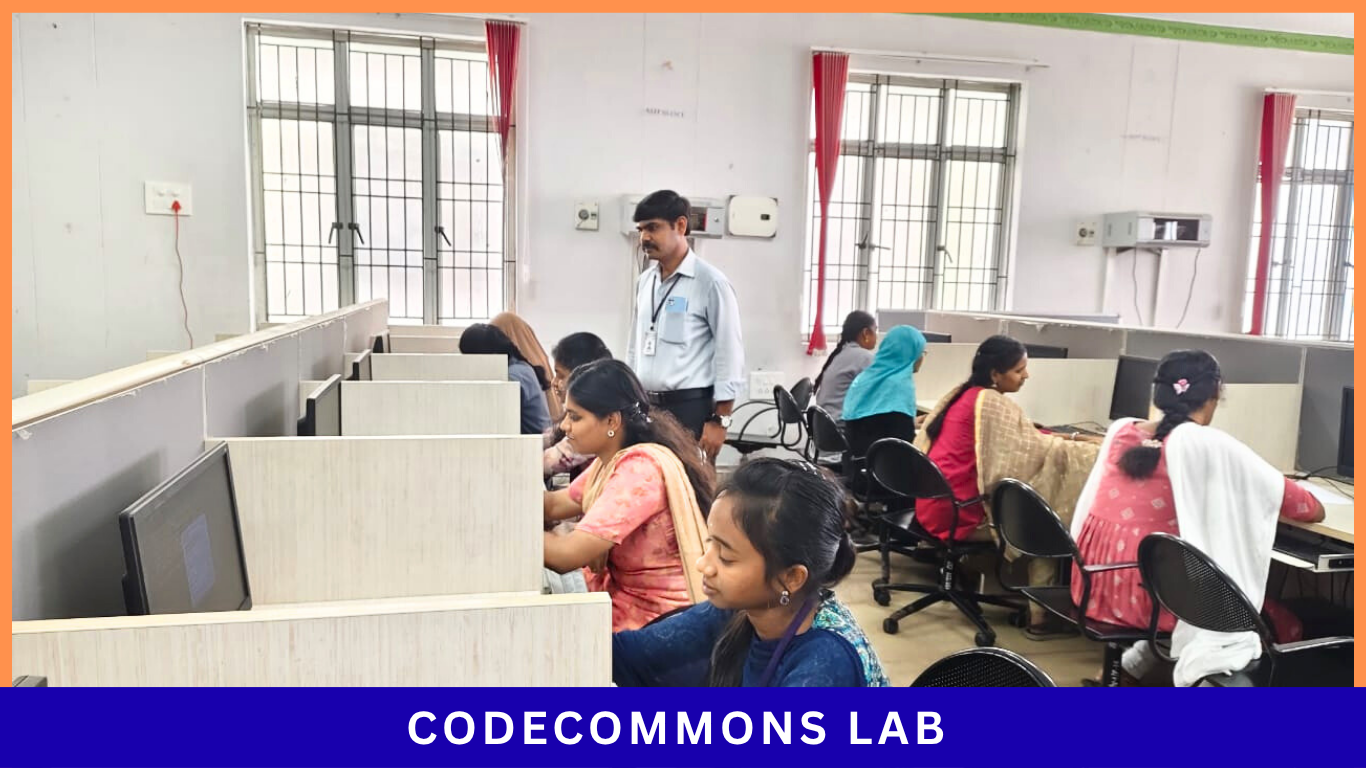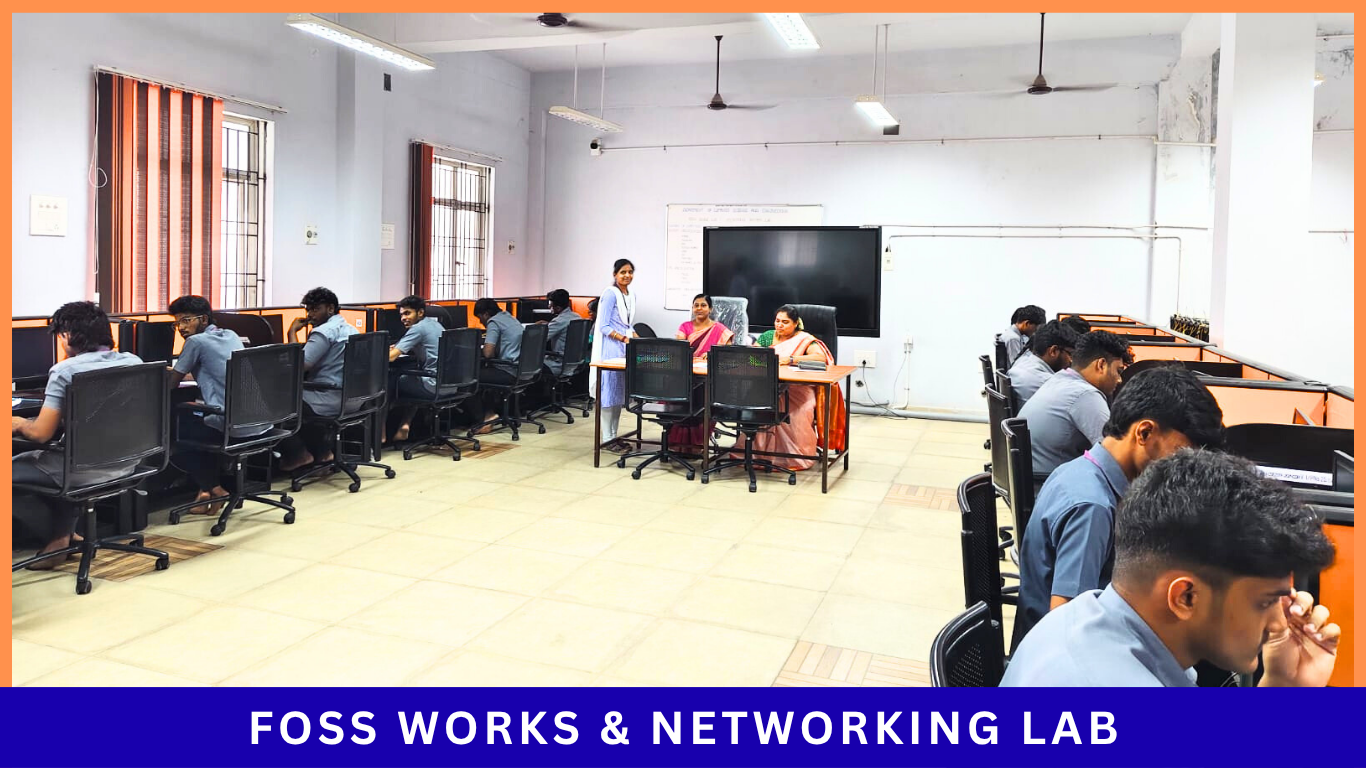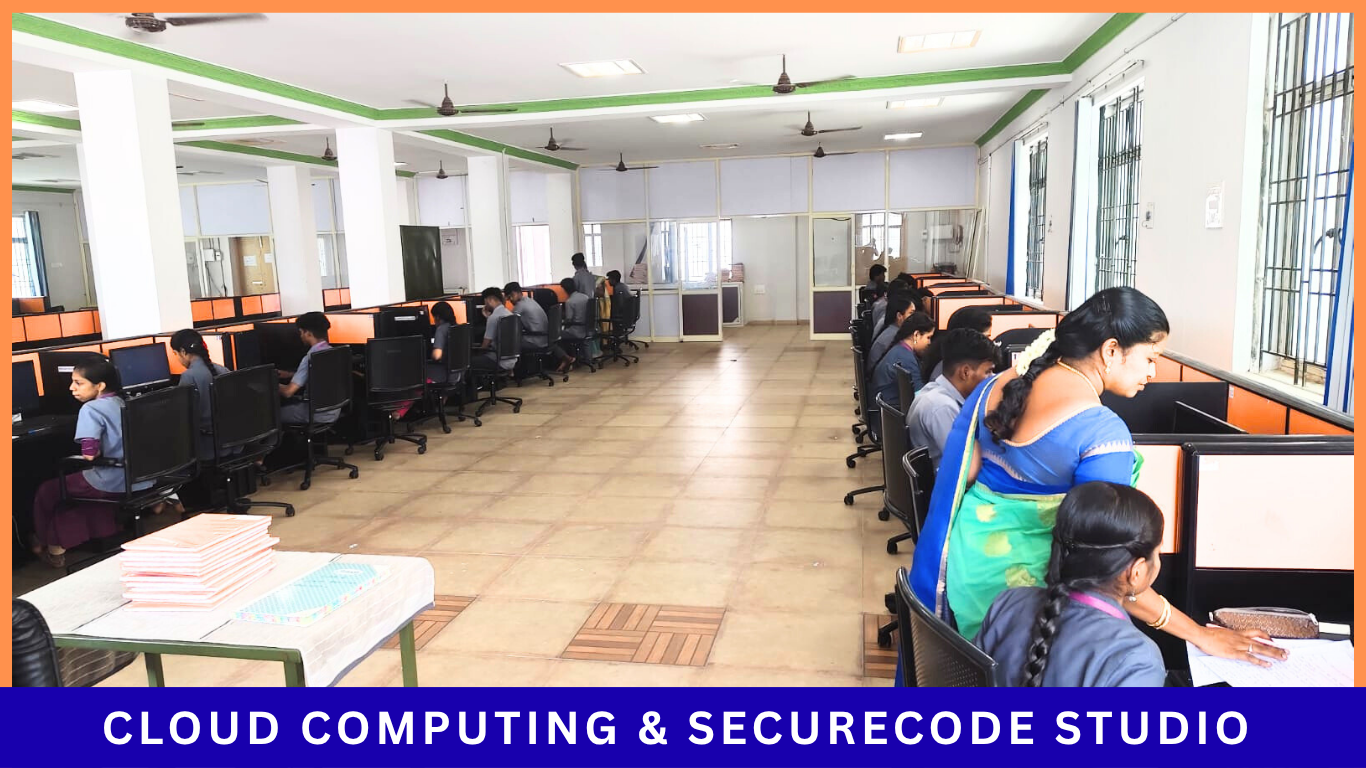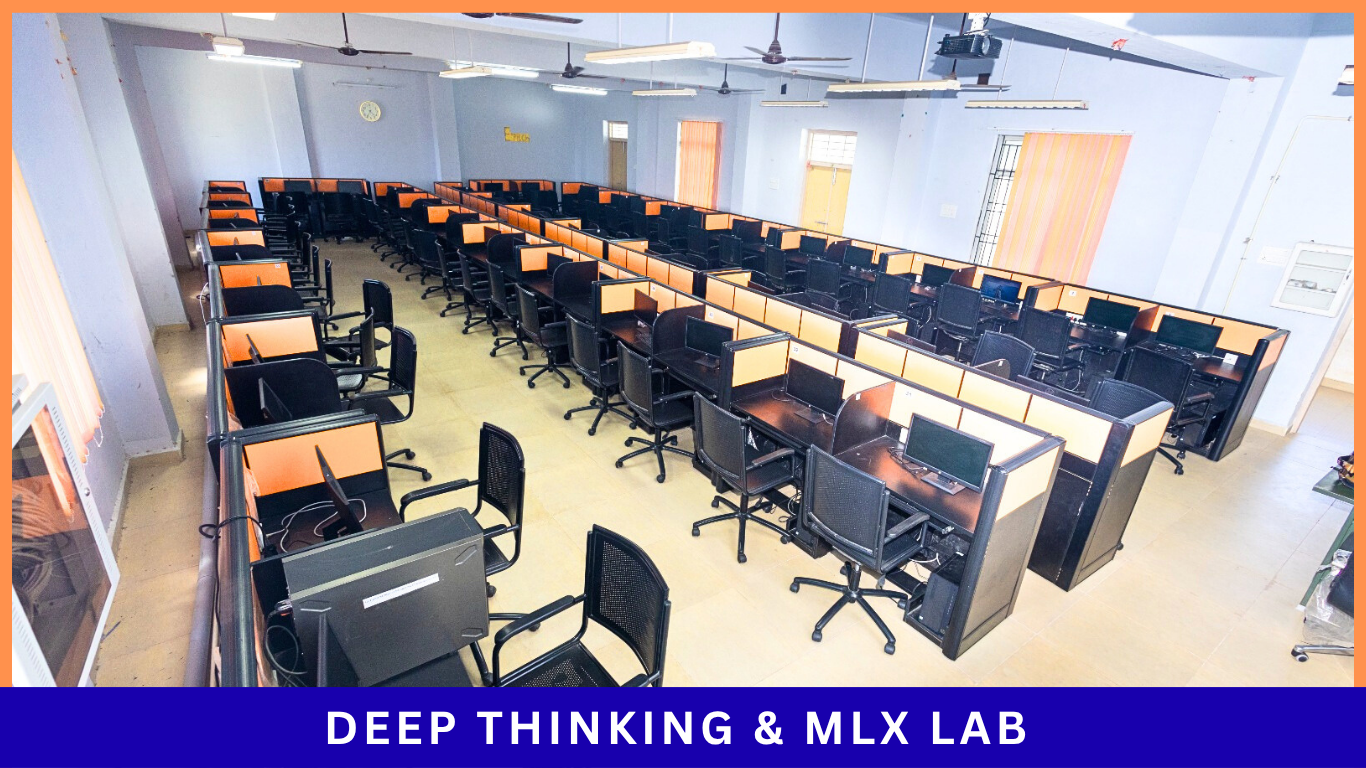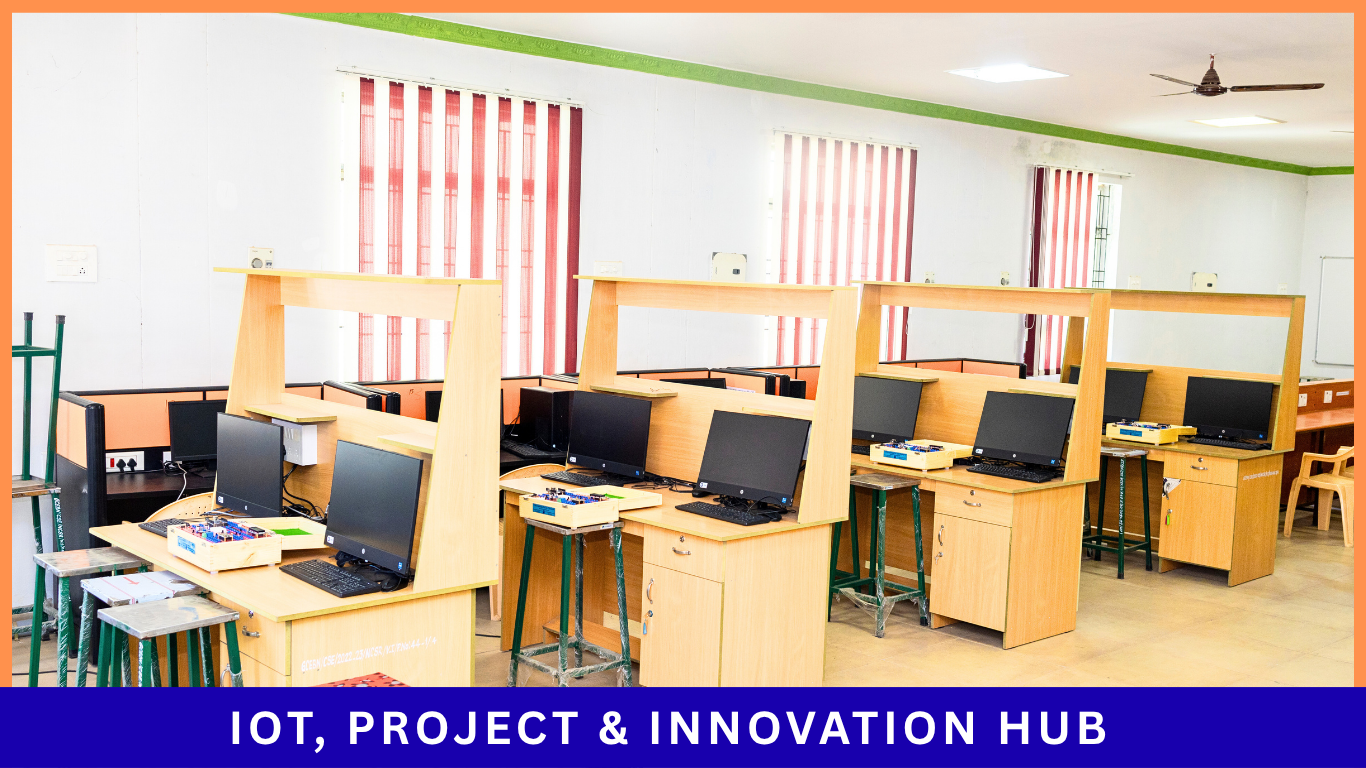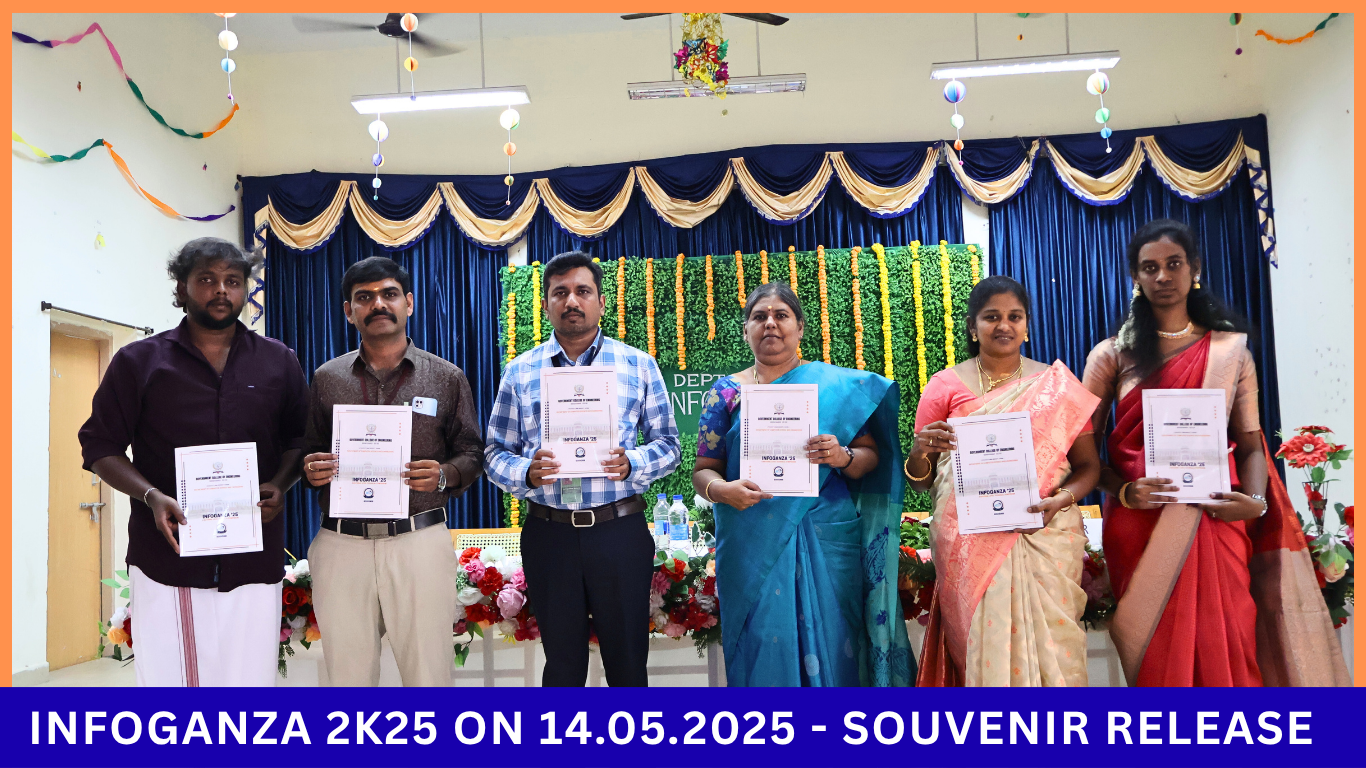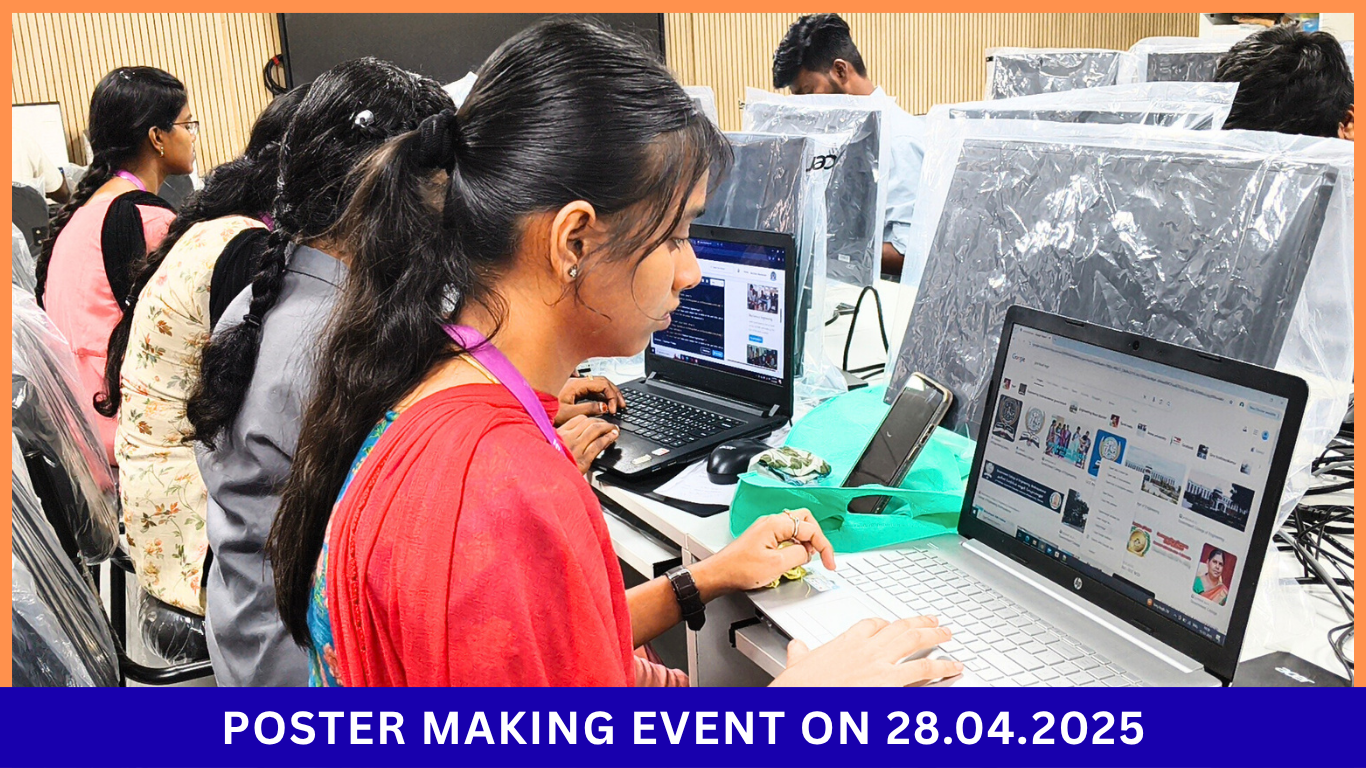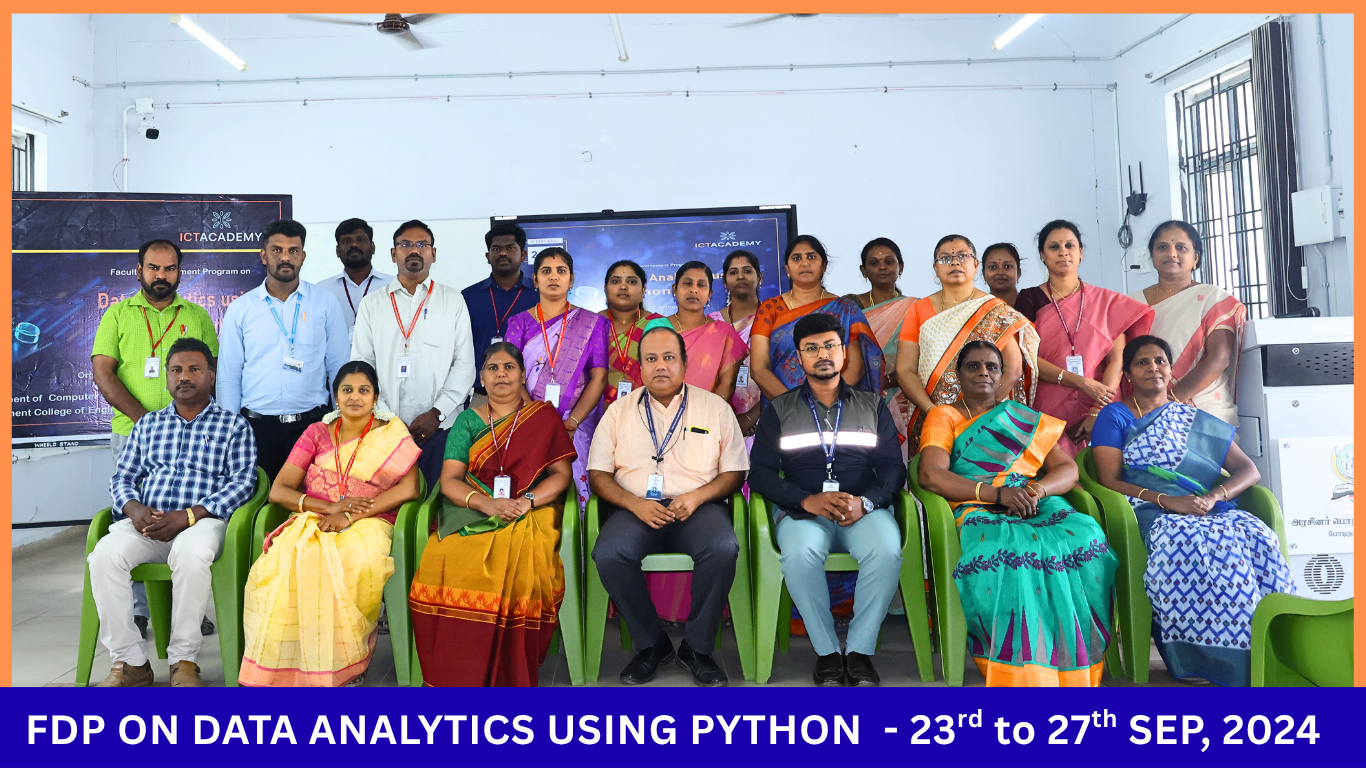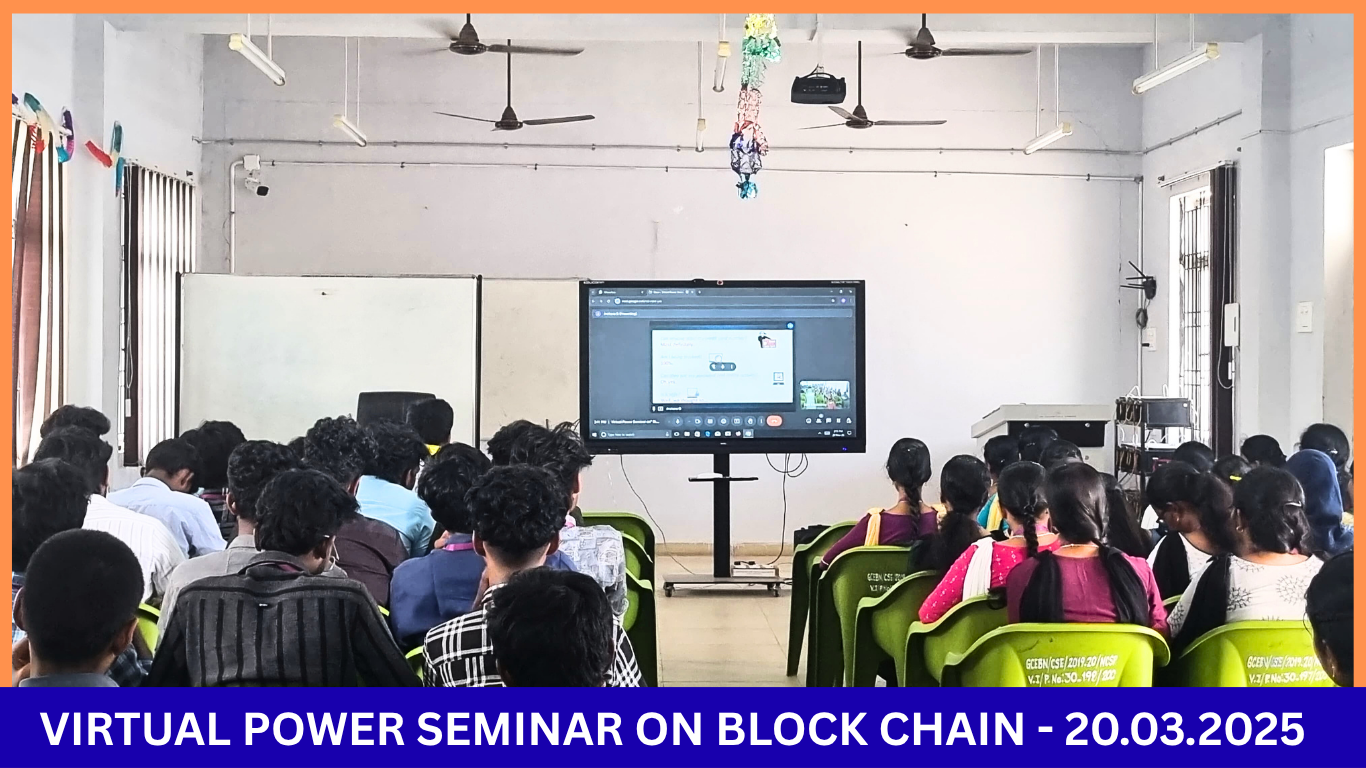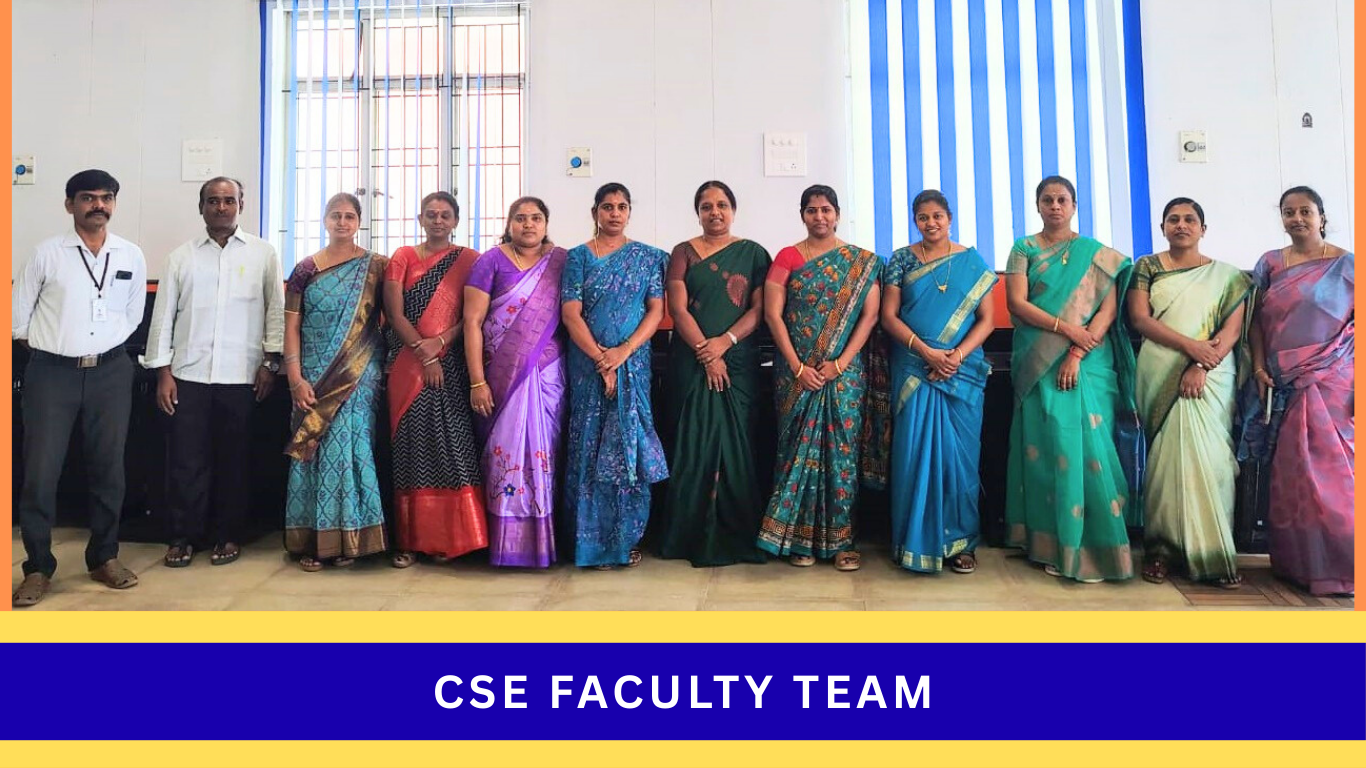- Laboratory 1: Codecommons Lab
Lab Specification:
- A total number of 55 branded computers are available for students’ practical classes.
- Relevant open source software needed for regular practical courses have been consolidated in the servers and students can access them from anywhere through intranet connectivity.
Two numbers of 10KVA online UPS to provide power backup facilities.
Sl.No Description Specification 1 Desktop i3 Dell optiplex 3010MT Intel core i3,3010MT CPU, 3.2 GHZ Speed, 8GB RAM, 500GB HDD 2 HP Desktop computer HP 8300 with preloaded OS Intel core i5,3470 CPU, 3.2 GHZ Speed, 6 MB Cache with intel Q77 Chipset, 500GB HDD 3 2 numbers of 10KVA online UPS with isolation transformer
- Laboratory 2: Cloud Computing and Secure code Studio
The Cloud Computing Lab at Computer Science and Engineering department is a state-of-the-art facility designed to immerse students in the dynamic world of cloud technologies. This lab provides hands-on experience with leading cloud platforms, enabling students to develop, deploy, and manage applications in real-world environments.
The Securecode Studio is a dedicated facility designed to provide hands-on experience and practical knowledge in the field of cyber security. The lab aims to equip students with the technical skills necessary to understand, detect, prevent, and respond to cyber threats and vulnerabilities across diverse digital platforms.Key Features
- Virtualization Tools: Utilization of platforms like VMware and VirtualBox to create and manage virtual machines.
- Cloud Platforms: Hands-on experience with services such as AWS, Microsoft Azure, and Google Cloud Platform.
- Cloud Simulators: Implementation of tools like CloudSim for modeling and simulating cloud environments.
- Secure Infrastructure: Isolated networks to safely conduct experiments without impacting external systems.
- High-performance workstations with secure and isolated lab environments.
- Virtualization platforms (VMware/VirtualBox) for simulating attack and defense scenarios.
- Simulated enterprise environments for conducting penetration testing and vulnerability assessments.
- Firewall, IDS/IPS setups for real-time security monitoring and analysis.
- Internet usage is strictly monitored and sandboxed for safe security practice.
Educational Impact
The Cloud Computing and Securecode Studio integrates seamlessly into the curriculum by:- Facilitating courses in cloud architecture, deployment, and management.
- Providing a platform for capstone projects and independent research.
- Enhancing understanding of cloud security, compliance, and best practices.
The Securecode Studio at Computer Science and Engineering department is a cutting-edge facility designed to provide students with immersive, hands-on experience in cyber security. Equipped with advanced hardware and software, the lab enables students to simulate real-world cyber threats, conduct penetration testing, and develop robust defense mechanisms. This environment fosters practical learning, allowing students to apply theoretical knowledge to protect digital infrastructures effectively.
Lab Facilities & Tools
The lab is equipped with state-of-the-art hardware and software to facilitate immersive learning experiences:- Hardware: High-performance workstations, secure servers, and networking equipment.
- Software & Tools:
1. Network analysis: Wireshark, Nmap, Zenmap
2.Vulnerability assessment: Nessus, Metasploit, Armitage
3.Penetration testing: DVWA, Burp Suite
4.Security information and event management: Splunk, Wazuh
5. Virtualization platforms: VMware, VirtualBox
These resources enable students to engage in activities such as network configuration, threat simulation, and incident response.
Cloud Computing and Securecode Studio System Configuration
1) ComputersNo of computers
60
Processor
Intel core i7-9700
Model
HP Desktop 280 GB
RAM
16 GB DDR4
Motherboard
Intel
HDD
1TB 7200 RPM SATA
Monitor
HP P240V 19.5”
Operating System
Windows 10
Programming Languages
C/C++, Python IDE (Anaconda Navigator), and Java for socket programming and network application development, CloudSim, GNS3 (Graphical Network Simulator-3), Packet Tracer, Boson NetSim
2) Server Workstation
Server OS
Microsoft windows Server 2019 standard
Processor
Intel ® Xeon ® E-2124 CPU @3.40GHz
Model
HP Z2 Tower G4 Workstation
RAM
32 GB DDR4
Motherboard
Intel
HDD
2TB 7200 RPM SATA
Monitor
HP P240V 19.5”
3) Uninterrupted Power supply(UPS) – 1 No
Model
BPSLF1, 10KVA online UPS
Make
BPS with 120mins SMF battery Backup
Battery
Exide powersafe 12V, 65 AH
4) Uninterrupted Power supply(UPS) – 1 No
Model
Numeric, 10KVA online UPS
Make
Tubular battery Backup with 120mins
Battery
TECORRECT make 12V, 65 AH
5) Touch Screen Interactive Display
Make
Newline
Newline Model
TT-75191, Slot- in PC OPS with 4k Resolution i5 Processor, 8GB RAM, 120 GB SSD, External HDD 1TB
6) Printer
Make
Epson
Model
M2140
Type
Ink tank Printer
- Laboratory 3:FOSSWorks and Networking Lab
Open Source Lab is designed to provide students with hands-on experience in understanding the concepts, architecture, and implementation of operating systems and computer networks. The OS lab is a cornerstone of technical education, helping students builds a strong foundation in system-level programming and network engineering.
Lab facilities:
1. A total number of 47 computers are available.- High-performance desktop computers or workstations with network configurations for simulation and testing.
- Servers for hosting and running networking applications and services.
2. Have a collaborative Touch Screen Interactive display to create more immersive learning experiences for students and help faculty plan lessons.
3. Have a projector for easy learning.
4. Have sufficient online UPS facilities which provides back up and to protect sensitive devices from damage.Operating Systems Used:
Linux (Ubuntu) and Windows 10
Operating System Development:
• Tools like GCC Compiler, Shell Scripting, and Virtual Machines for OS experiments.
• Simulators to visualize scheduling algorithms, memory management, and file systems.
Programming Languages:
• C/C++, Python, and Java for socket programming and network application development
Features and Benefits
• Hands-On Experience:
Provides real-world experience in OS and network optimization, SDN, IoT protocols and custom OS modules, preparing students for challenges in these domains.Collaborative Touch Screen Interactive Display:
The benefits of collaborative displays can extend outside of the enterprise environment. For some time now, countless educational institutions have used these devices to create more immersive learning experiences for students and help faculty plan lessons.Projector facility:
Teaching with a projector is more interactive. With recorded presentations or using a projector as a monitor for your laptop or pc, we can easily teach and students can focus on learning and conceptual study.Configuration of the Computers
Number of Computers : 47
Model : HP Desktop 280 GB
Processor : Intel core i7-9700
RAM : 16 GB DDR4
Motherboard : Intel
HDD : 1TB 7200 RPM SATA
Monitor : HP P240V 19.5”
UPS Specification
Model : BPSLF1, 10KVA online UPS
Make : BPS with 120mins SMF battery Backup
Battery : Exide make 12V, 65 AH
Collaborative Touch Screen Interactive Display Specification
Make : Newline
Model : TT-75191, Slot- in PC OPS with 4k Resolution i5 Processor, 8GB Ram, 120 GB SSD, External HDD 1TB
Projector specification details
Projection display unit with DLP technology and a resolution of XGA (1024*768)
- Laboratory 4: DeepThink and MLX Laboratory
The primary objective of this laboratory is to develop a deep understanding of various data structures, their operations, and their applications. Students will gain proficiency in implementing data structures using programming languages such as C, C++, Java,python. The lab encourages experimentation with different types of data structures to solve computational problems efficiently.
Tools and Technologies:
• Programming Languages: C, C++, Java,ArgoUML, DevOPS, Python.
• Integrated Development Environments (IDEs): Eclipse, Visual Studio, or others as per course requirements.
• Algorithms Visualization Tools.
Lab Facilities:
• A total number of 58 computers with internet connection are available.
• All in one PC
• Have sufficient number of online UPS’s to provide power backup facilities.
Projector facility:
Projectors enhance students' learning experiences by making lessons more interactive, engaging, and accessible. They help in delivering diverse content and promoting collaboration and critical thinking, all of which contribute to a well-rounded educational experience. Whether for traditional classroom settings, group work, or remote learning, projectors is a valuable tool that supports various teaching methods and student needs.
Sl.No
Description
Specification
1
HP Desktop computer HP 9700 with preloaded OS
Model: HP DESKTOP 280 GB
Processor: Intel core i7, 9700
RAM:16GB DDR4
Mother Board: INTEL
HDD: 1 TB 7200 RPM SATA
OS: Windows 10 Professional 64 Bit
Moniter: HP P2424OV 19.5
Keyboard & Mouse: HP MAKE
10KVA online UPS with isolation transformer
- Laboratory 5:Project & Innovation Hub
IoT Lab is a state-of-the-art facility designed for research, innovation, and hands-on learning. Students explore microcontrollers, sensors, wireless communication, and real-time systems to build intelligent solutions for smart cities, healthcare, and automation.
Lab Facilities & Equipment:
• High performance All in one Desktop Computers with 12th Gen, i5 processor, Microsoft Windows 11 Operating System
• IoT Development Kit with work bench setup
• Consist of 18 computers with high speed internet connectivity.Hardware Development Kit:
• Hardware Development Kit:
• Microcontroller Board: Arduino Uno ATMEGA 328 MCU with 32K on chip memory
• Microcontroller Board: Node MCU ESP-8266/ESP32 MCU with atleast 4 MB on Chip memory
• Operating Voltage:5V
• Digital I/O Pins:14(of which 6 provide PWM output).
• 16x2 Character Alphanumeric LCD
• 2 push button Switches
• 10 user LEDs for output
• One mini bread board
• Onboard LM 35 tempereature Sensor
• On board Ultrasonic Sensor
• Onboard IR sensor Analog Output
• On board Servo motor interface(5V DC)
• 1 analog potentio meters for ADC input
• Onboard relay interface(5V DC)
• Manual with Application examples.Components:
• Push button switches
• Resistor 330KΩSoftware & Simulation Tools:
Keil, PythonResearch & Projects:
1)Students can do featured Projects on Smart Home Automation System, Health Monitoring System.
• Project Lab: Dedicated PCs for final-year projects with modern IDEs (Android Studio, XAMPP) enabling hands-on prototyping and team collaboration
• R&D Lab: Equipped with GPUs, i7 workstations, and specialized software for cutting-edge research in computer vision, NLP, IoT, robotics, cyber-security, etc.
- Other Facilities
1) High Speed Networking & Connectivity
• All computer labs are connected via gigabit Ethernet and fibre optics.
• Backbone comprises L3-managed switches, Fibre enabled aggregation switches, Distribution switches, firewall.
• Emphasize 24×7 access, UPS backup, fiber connectivity and Wi Fi coverage.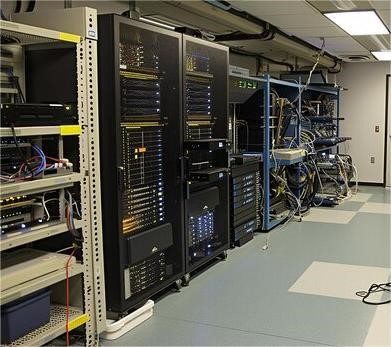
2) Seminar Halls & Classrooms
Seminars and workshops are held in departmental seminar halls (with a capacity of 110), equipped with Interactive touch display, LCD projectors and teleconferencing facilities.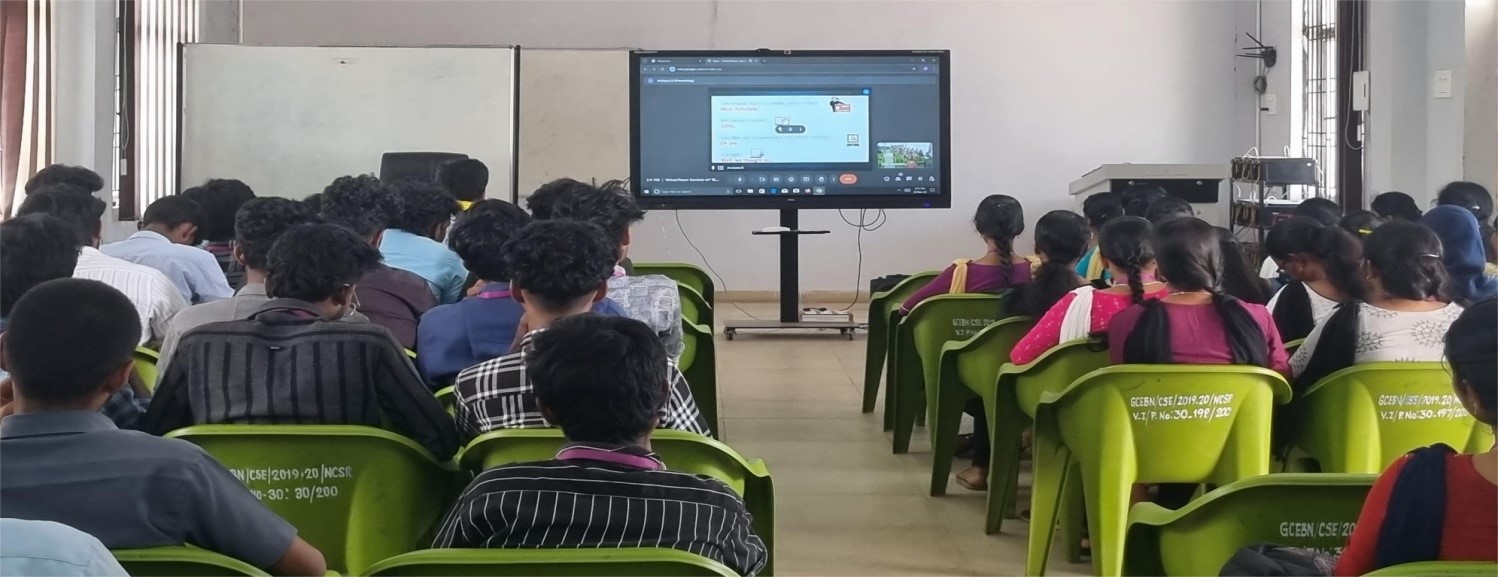
3) Dedicated Libraries & e Resources
• Departmental library is specialized with CS & IT collections of about 500 volumes along with central libraries with access to thousands of e journals (IEEE, ACM, Springer)
One Nation One Subscription (ONOS) Key Features
Our students and faculty have access to ~13,000 international journals from the world’s top 30 publishers—Elsevier, Springer Nature, Wiley, Taylor & Francis, IEEE, Cambridge, BMJ, ACS, and more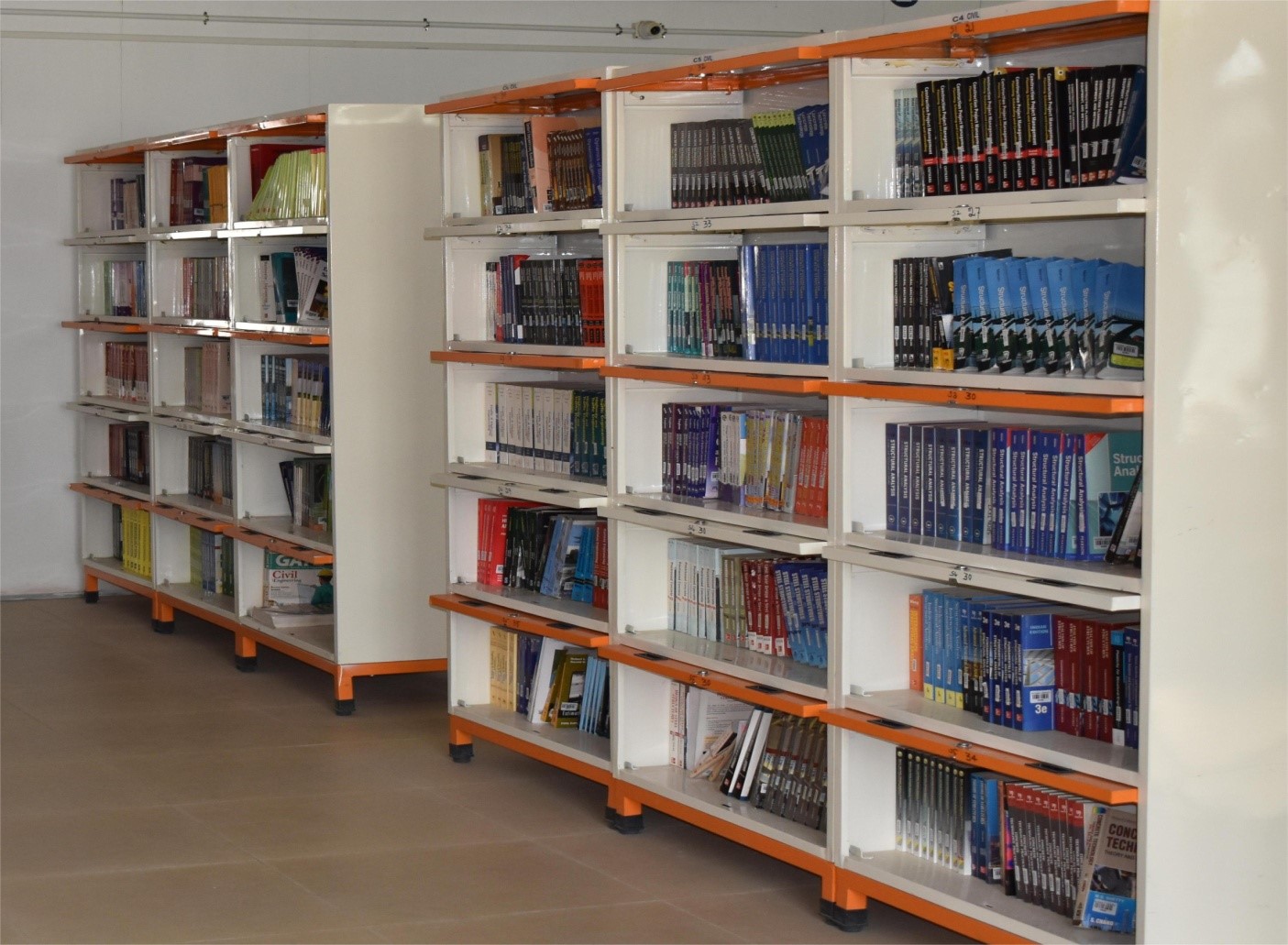
4) Smart Classrooms: Next-Gen Learning Spaces
Smart Classrooms
The CSE department is equipped with advanced learning spaces featuring 85″ interactive 4K touch displays, high-definition audio-visual systems, HD PTZ cameras, and seamless Wi-Fi connectivity. These smart classrooms support hybrid teaching through integrated video conferencing, lecture capture, and cloud-based learning management systems.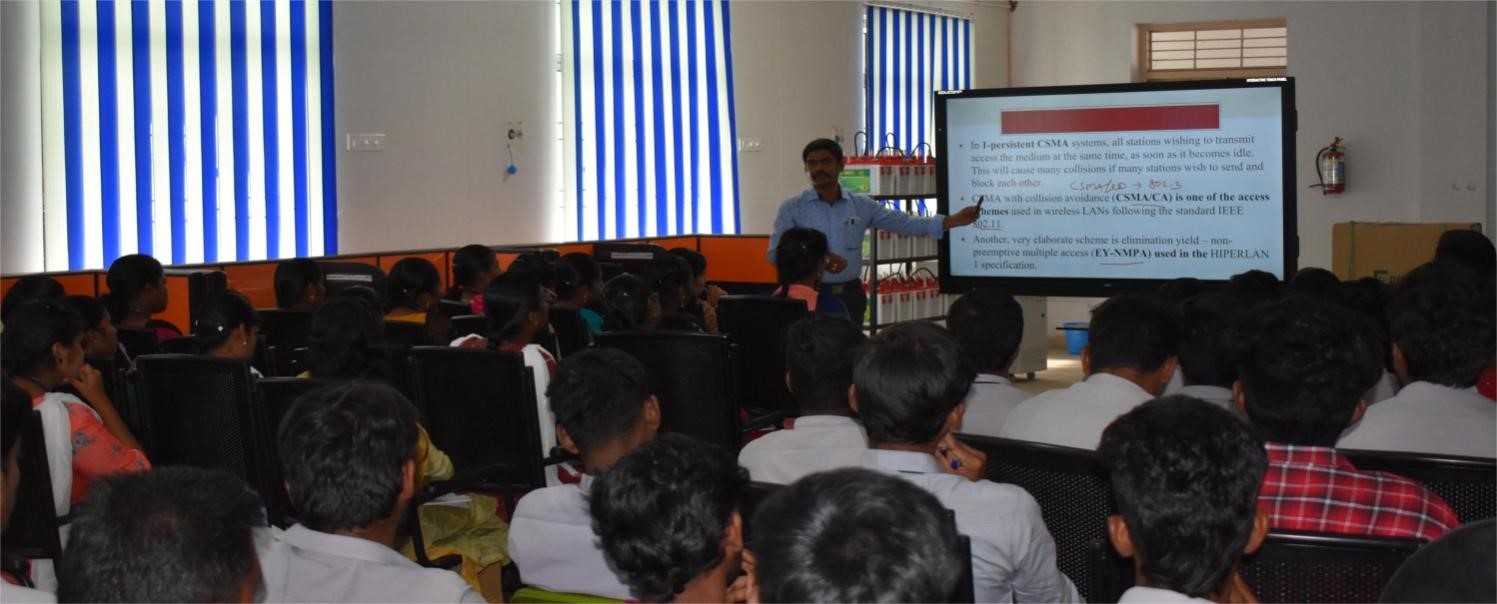
5) Interactive Displays & Presentation Tools
• 85″–100″ 4K interactive touch screens for immersive lectures and collaborative sessions.
• Smart projectors and smart boards let instructors annotate content and share multimedia—boosting engagement.
• Teaching aids like visualize is available for teaching-learning process.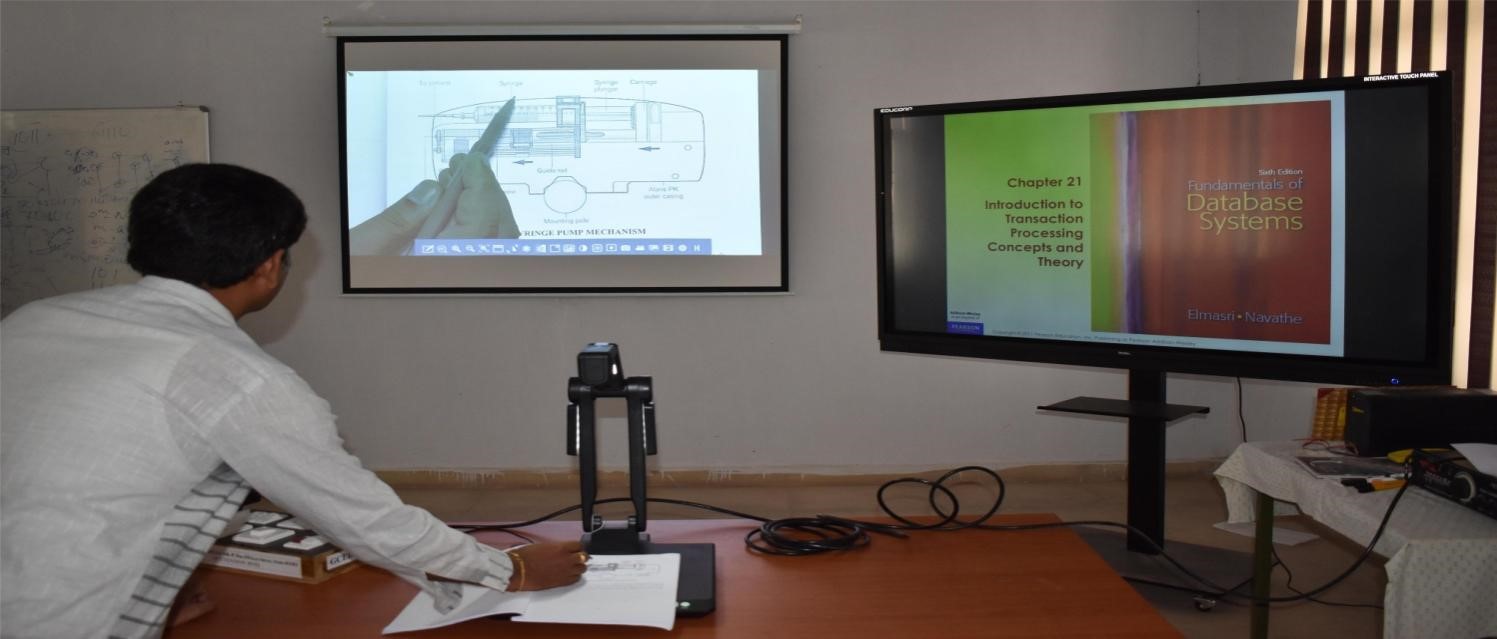
6) Audio Visual & Conferencing Systems
• High-quality audio systems (speakers, mic, mixers) ensure clarity in large spaces.
• HD PTZ cameras enable dynamic capture of class interactions—ideal for remote or hybrid learning.
• Video-conferencing tools with real-time interaction for guest lectures, webinars, and global collaboration

